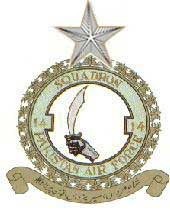|
No 14 Fighter-bomber Squadron was formed at Peshawar on 1 November 48 with Squadron Leader Khyber Khan as the first squadron commander. After being number- plated on 15 January 49, it was reactivated on 16 December 49 under the command of Squadron Leader J K Zuromski. The squadron left for Miranshah on 24 March 50 on its first operational deployment. Its task was to police the tribal areas of North Waziristan in order to contain the insurgency fomented by the Faqir of Ipi.
In 1954 the squadron went through various memorable experiences like the activation of Tezgaon airfield at Dhaka in March, an air display for King Saud at Peshawar in April, a fire power demonstration at Fort Sandeman in May and exercise 'November Handicap' in November. In 1955 there was a summer camp at Samungli in May, a fly past over the Pakistan Day parade in Karachi in August and another tour at Miranshah in October and November. In September 56, No 14 Squadron pilots started leaving for F-86 MTD classes which had been set up at Drigh Road. The squadron moved to Mauripur in November and soon became operational on the Sabre. In November 57 it took part in the naval exercise 'Crescent' and an army co-op exercise 'Yellow Lizard'. In March 59 the squadron won the Perry-Keene armament trophy with a comfortable margin. While in Mauripur the squadron also participated in CENTO exercise 'Shahbaz'. In March 64, the squadron again won the coveted Perry- Keene armament trophy. Soon to follow was another Samungli camp from 20 May to 30 June 64 and then, on 7 October 64, the unit was permanently moved to Dhaka, under the command of Squadron Leader Shabbir Hussain Syed who had taken over in March 63.
No 14 Squadron's exploits during both the 65 and 71 wars constitute an unforgettable part of the PAF's history and have been graphically described in this book in the chapters titled 'Triumph in the East' (1965) and 'Intrepid under Siege' and 'Three Days of Fury' (1971). Here it would be sufficient to mention the high point of each episode.
The strike against Kulaikunda on 7 September 65 was led by Squadron Leader Shabbir with Flight Lieutenants Haleem, Baseer and Tariq Habeeb and Flying Officer Afzal Khan as formation members. They took off at 0631 hours with two 120 and two 200 gallon tanks and gun ammunition only. The formation arrived over the target without being intercepted and caught 14 Canberra's neatly lined up on the tarmac. The formation put in two attacks each on these Canberra's and on three Hunters also parked on the tarmac; they destroyed ten Canberra's and damaged the rest as well as two Hunters. Squadron Leader Shabbir and Flight Lieutenant Tariq Habib were awarded Sitara-i-Juraat.
In 1971, placed in a no win situation against a force of 10 IAF squadrons comprising Mig-21 s, Su-7s, Gnats and Hunters, No 14 Squadron kept the flag flying till literally the last gasp. Their peerless valour won them six Sitara-i-Juraats. In July 72, No 14 Squadron was reformed with F-6 aircraft at Sargodha under the command of Wing Commander Muhammad Afzal Chaudhry. When Wing Commander J A Carrapiett took over in April 73, plans were underway to assign the squadron the role of an Operational Conversion Unit (OCU). The, plan ultimately crystallized in January 1974 where after the squadron successfully graduated 10 pilots of the first OCC on 6 November. At this stage the unit was moved to Mianwali which was then an upcoming training base.
On 1 November 76 the squadron was presented with its colour by General Muhammad Sharif, Chairman joint Chiefs of Staff Committee. The parade was commanded by the squadron commander Wing Commander Anwar-ul-Haq Malik while the colour bearer was Flying Officer Abrar Ahmed Tahir. The squadron colour has the battle honours of Kulaikunda 1965' and Dhaka 1971' on two of the six scrolls.
To facilitate the unit's training role, a trainer version of the F-6, the FT-6, was added to the squadron inventory in May 77 when FT-6s were ferried across from China. During the ferry flight however, a valuable member of the team was lost over the Himalayas, after ejecting from his disabled FT-6.
During its tenure as an OCU, No 14 Squadron had graduated over 100 pilots operationally trained on the F-6.
In September 86, the squadron was reequipped with F-16 multi-role aircraft. After reforming in Sargodha under the command of Wing Commander Sheikh Amjad Javed the squadron flew over to Kamra where an impressive reequipment ceremony was held on 2nd October 1986 reviewed by the Chief of the Air Staff. Wing Commander Amjad Javed commanded the parade and Squadron Leader Sohail Gul Khan and Flight Lieutenant Badar Islam were the old and new colour custodians respectively.
|

